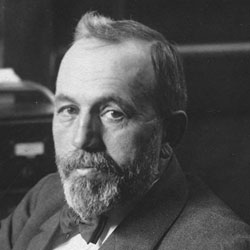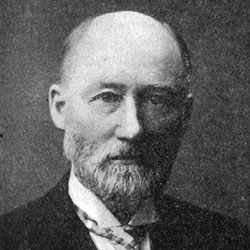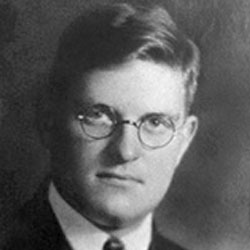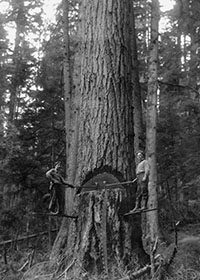
Forestry students watching a water activity, Field Day 1918

When the University of Michigan was founded in 1817, a vast forest of white pine carpeted swaths of Michigan’s lower and upper peninsulas, trees often reaching heights of 200 feet. Within a few decades, rivers like the Saginaw were choked with timber bound for the sawmills—as the nation’s demand for lumber outgrew its supply.
By 1903, the great white pine forests of Michigan had been cut over and left as wastelands. Now burdened with a tinderbox of abandoned tree tops on soil unsuitable for farming, landowners often chose to surrender their “stump prairies” to the state rather than pay delinquent taxes.
In Michigan, and throughout the country, there was a call for leadership in the restoration of these deforested lands. There was little time to waste in addressing the state of the nation’s forests.
U-M responded to the call by establishing a Department of Forestry, chaired by Filibert Roth (MS 1890). Roth had studied forestry under Volney Morgan Spalding, the U-M botany professor who had established the nation’s first courses in forestry in 1881.
Under Roth’s direction, the curriculum and faculty rapidly expanded to keep pace with developments in the forestry profession. And while Roth fully embraced the emerging science of forestry, he also believed that the best place to learn forestry was in the forest—and led his students on regular excursions into Saginaw Woods, U-M’s 80-acre reserve, to plant trees and improve the soil.
As this new breed of “science-based” foresters moved into positions of influence, Roth came closer to his dream of bringing responsible forest management to Michigan, as well as to the country as a whole.
Roth’s vision—and the department he led for 20 years—embodied the core values that would define the future school throughout the 20th century and into the next: an education rooted in science, reinforced by field-based learning, and driven by a commitment to the public good.
In accordance with its desire and aim to be of the utmost service to Michigan, the University is strengthening its work in training men in the science and art of forestry. One of the gravest economic problems in our state is presented by the desirableness of restoring, if possible, the forests which have been destroyed and of properly caring for the woodlands which are still left.
 |
FILIBERT ROTH (MS 1890)Born in Württemberg, Germany, in 1858, Roth was the son of a German father and a Swiss mother. The family emigrated to Wisconsin when Roth was 12. After graduating from U-M in 1890, Roth was known as a leading expert in the new field of “timber physics.” He served in top positions at the U.S. Departments of Agriculture and the Interior before beginning his role (1903 -1923) as chair of U-M’s Department of Forestry. Much beloved by his students for his down-to-earth manner and heartfelt encouragement, he earned the moniker of “Daddy Roth.” |
 |
1881: First Courses in ForestryVOLNEY MORGAN SPALDING established the first full-semester course in forestry in the nation within the School of Political Science at the University of Michigan in 1881. Spalding later encouraged his former pupil, Filibert Roth, to lead the newly formed Department of Forestry in 1903. |
 |
Edmund Zavitz (MS 1905) "Father of Reforestation"As one of the earliest alumni of the newly established Department of Forestry, Edmund Zavitz became the first provincial forester in his native Ontario, eventually rising to the positions of Deputy Minister and Chief of Reforestation. Photographs from his travels throughout the province revealed a desert-like landscape, and supported his crusade for reforestation and conservation. Through his efforts, conservation authorities, provincial nurseries, forestry stations, and bylaws protecting trees were established. The Forest Fires Prevention Act and the inception of the provincial air service are also attributed to Zavitz. Just before his death in 1968, the billionth tree was planted by Ontario Premier John Robarts—with two billion to follow. “Two Billion Trees and Counting: |
 |
Great Lakes Forest SurveyThe forestry department was about more than teaching. Practical application of the knowledge and training generated from the department made a real difference in the management of forests on a statewide and national level. One example occurred in 1922, when Roth and Department of Forestry Professor Robert Craig assembled a team, including George Banzhaf, to survey and assess management alternatives on over 250,000 acres in the Upper Peninsula of Michigan. The Michigan graduates who worked on this massive project learned their field skills at Camp Davis, now the U-M Biological Station, located on Douglas Lake near Pellston, Mich. The Great Lakes Forest Survey was the first attempt in the United States to assess the suitability of cut-over land for forest and agricultural management. Based on the importance of this effort, the governor of Michigan established one of the first statewide forest fire protection plans. |

Forestry students watching a water activity, Field Day 1918